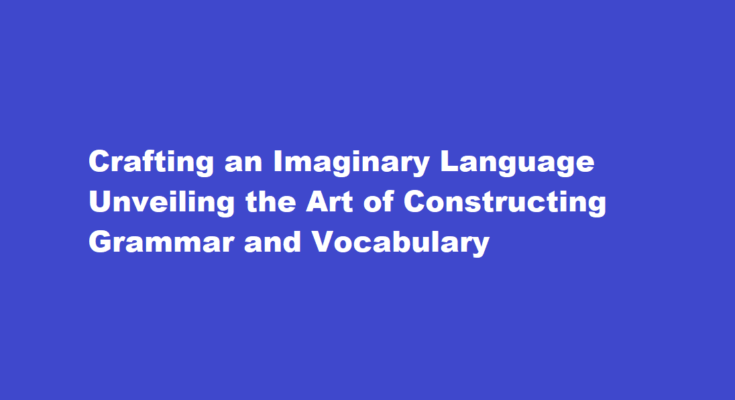Introduction
Language, as a powerful tool of human expression, serves as the foundation of communication and culture. Beyond the confines of existing tongues, lies the realm of constructed languages, or conlangs, where creators breathe life into entirely new linguistic universes. Constructing an imaginary language can be a stimulating and rewarding endeavor, unlocking creativity and a deeper understanding of linguistics. In this article, we will explore the step-by-step process of creating a unique imaginary language, complete with its grammar and vocabulary.
Establishing Purpose and Inspiration
Before embarking on the journey of creating a conlang, define its purpose. Will it serve as an artistic element in a novel or movie, or will it be a functional language for a fictional civilization in a role-playing game? Understanding the purpose will guide the design process and shape its overall character.
Seek inspiration from diverse linguistic sources, such as phonetics from endangered languages, grammatical features from ancient tongues, or intriguing word structures from lesser-known dialects. Drawing from real-world examples can provide a sense of authenticity to your imaginary language.
Developing Phonetics and Phonology
The sounds of your conlang, known as phonetics and phonology, are the building blocks of communication. Choose a set of consonants and vowels to create a distinctive sound system. Consider the ease of pronunciation, as excessively complex sounds may discourage learners from embracing the language.
Next, craft rules for syllable structures and stress patterns. Experiment with different combinations of sounds to give your language a distinct cadence and rhythm.
Crafting Grammar and Syntax
Grammar is the structure that governs how words interact and form sentences. Begin with the essentials, such as nouns, verbs, adjectives, and adverbs. Determine how word order affects meaning and whether your conlang employs a subject-verb-object (SVO) or a different pattern.
Develop a system of noun cases, verb conjugations, and tenses. Decide how your language handles plurals, gender, and articles. Introduce new concepts where desired, but ensure consistency and logical coherence in the rules.
Building Vocabulary
The lexicon of your conlang is its soul. Start with essential words like pronouns, numbers, and common verbs. Gradually expand the vocabulary to cover various aspects of life, including emotions, nature, and technology. Draw inspiration from the world around you, but don’t be afraid to invent entirely new terms to reflect the unique aspects of your imaginary culture.
Consider creating compound words or deriving new words from existing ones, just like natural languages evolve over time. This can lend depth and history to your conlang.
Evolving Culture and Context
The development of a conlang should be intertwined with the culture and context of the fictional world it inhabits. The language might adapt to reflect societal norms, religious beliefs, or even environmental factors. Explore how the language influences the thought processes and worldview of its speakers.
Documenting and Sharing
As your conlang takes shape, document its grammar rules, vocabulary, and pronunciation guidelines. This linguistic blueprint will prove valuable when using the language consistently in various creative projects.
Consider creating an online platform or community to share your conlang with others interested in constructed languages. Engaging with fellow conlangers can lead to constructive feedback and new ideas for refining your creation.
FREQUENTLY ASKED QUESTIONS
Can we create our own language?
Designing new languages from scratch is an art and a science, and just like with many other intellectual and (semi-)academic endeavours, there’s an established precedent for how to do it effectively. If you’ve always wanted to create a language but aren’t sure what steps to take to get started, keep reading!
What is it called when you make up your own language?
A constructed language (shortened to a conlang) is a language whose phonology, grammar, and vocabulary, instead of having developed naturally, are consciously devised for some purpose, which may include being devised for a work of fiction.
Conclusion
Creating an imaginary language is an artistic journey that allows one to immerse in the realm of linguistic invention. By thoughtfully developing phonetics, grammar, and vocabulary, and weaving cultural context into its fabric, a conlang can achieve depth, authenticity, and intrigue. Whether as a tool of storytelling, a means of enhancing a fictional world, or simply a personal creative endeavor, the art of crafting an imaginary language promises a fulfilling and unique linguistic adventure. Embrace the challenge and let your imagination soar into uncharted linguistic territories.
Read Also : Mastering The Art of Effective Persuasion and Influence Unlocking the Power of Communication



